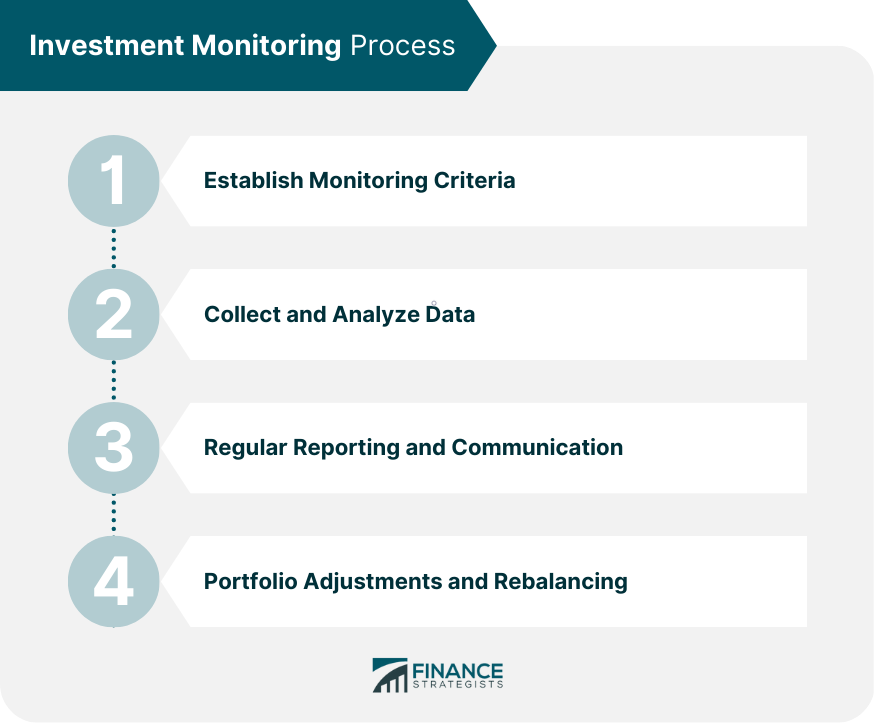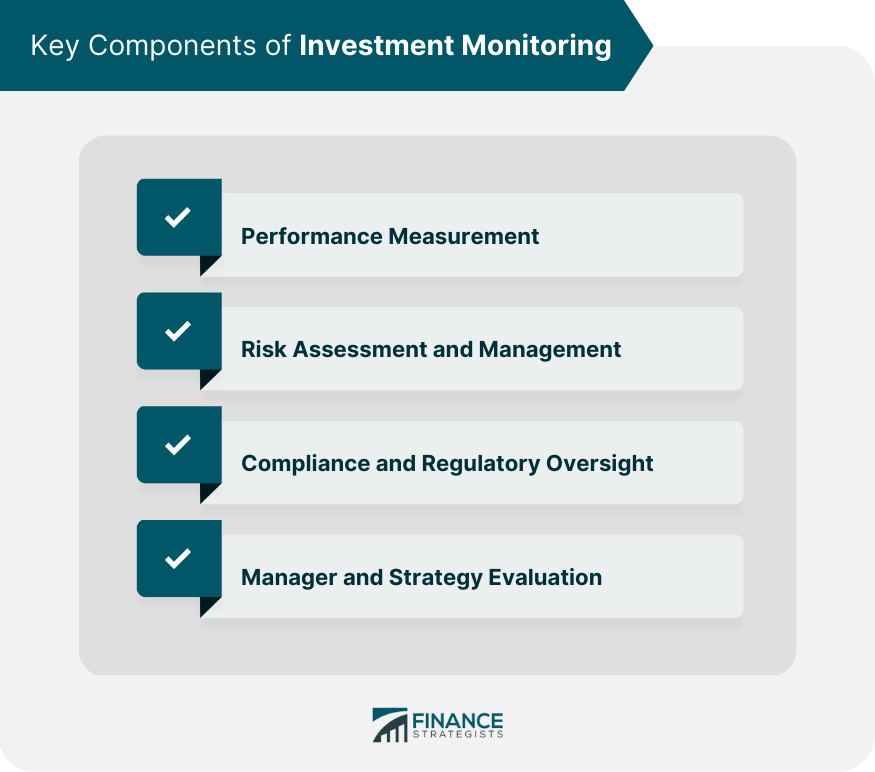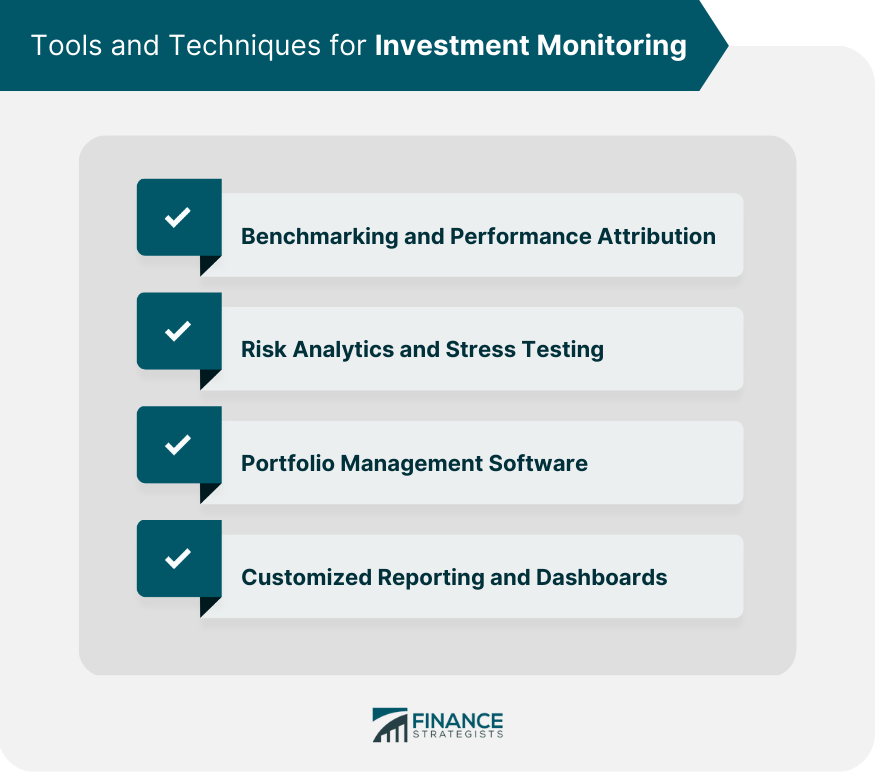Investment monitoring refers to the ongoing process of tracking and evaluating the performance of an investment portfolio, ensuring that it remains aligned with an investor's financial goals and risk tolerance. This process includes the assessment of investment returns, risks, and asset allocation, among other factors. Investment monitoring is essential for maintaining a well-performing portfolio and achieving long-term financial objectives. It enables investors to identify potential issues, respond to market changes, and make informed decisions about their investments, ultimately reducing the likelihood of underperformance or significant losses. The primary objectives of investment monitoring are to protect and grow the investor's capital, maintain optimal asset allocation, manage risk exposure, and ensure regulatory compliance. Through effective investment monitoring, investors can stay on track to achieve their financial goals and adapt their strategies as needed. The first step in the investment monitoring process is to establish clear criteria for evaluating the performance and risk of the portfolio. These criteria should be based on the investor's specific financial goals, risk tolerance, and investment horizon and may include metrics such as return on investment, risk-adjusted performance, and diversification. Investment monitoring involves collecting and analyzing relevant data, such as market prices, investment returns, and macroeconomic indicators. This data is used to evaluate the performance and risk of the portfolio, as well as to identify trends and potential opportunities for improvement. An essential aspect of investment monitoring is regular reporting and communication. Investors should receive periodic updates on their portfolio's performance, risk exposure, and any recommended adjustments. This ensures transparency and allows investors to make informed decisions about their investments. Based on the findings from the monitoring process, investors may need to make adjustments to their portfolio, such as rebalancing asset allocations or replacing underperforming investments. These adjustments help maintain optimal portfolio performance and ensure alignment with the investor's financial goals and risk tolerance. Performance measurement involves tracking the returns of individual investments and the overall portfolio, typically using metrics such as total return, annualized return, and risk-adjusted performance. This allows investors to assess whether their investments meet their expectations and contribute to their financial goals. Risk assessment and management are crucial aspects of investment monitoring. This includes evaluating the portfolio's exposure to various risks, such as market, credit, and liquidity risks, as well as implementing strategies to mitigate potential losses or volatility. Investment monitoring also encompasses ensuring compliance with relevant laws, regulations, and industry standards. This may involve adhering to investment restrictions, monitoring trading activities for potential violations, and maintaining proper recordkeeping and reporting practices. For investors who rely on professional investment managers or advisors, investment monitoring includes evaluating the performance and effectiveness of these professionals and their chosen strategies. This can help identify areas for improvement and ensure that the portfolio remains aligned with the investor's financial objectives. Benchmarking involves comparing the performance of a portfolio to an appropriate market index or industry benchmark. Performance attribution analyzes the sources of a portfolio's returns, helping investors understand the impact of individual investments and investment strategies on overall performance. Risk analytics tools provide detailed information about a portfolio's exposure to various risks, such as market, credit, and liquidity risks. Stress testing simulates the potential impact of extreme market events or changes in economic conditions, allowing investors to evaluate the resilience of their portfolios. Portfolio management software can help automate and streamline the investment monitoring process, providing investors with real-time data, performance analytics, and risk assessments. These tools can also facilitate portfolio adjustments and rebalancing, ensuring that investment strategies remain aligned with financial objectives. Customized reporting and dashboards offer investors an easy-to-understand visual representation of their portfolio's performance, risk exposure, and compliance with investment guidelines. This can enhance communication between investors and investment managers or advisors, promoting transparency and informed decision-making. Investment monitoring relies on accurate, timely, and complete data to assess portfolio performance and risk. Data quality and availability challenges can limit investment monitoring effectiveness and lead to suboptimal investment decisions. Market volatility and unpredictability can make investment monitoring more challenging, as rapid changes in market conditions can impact portfolio performance and risk exposure. Investors need to remain vigilant and adapt their monitoring strategies to respond effectively to market fluctuations. The increasing variety of investment vehicles and strategies can complicate investment monitoring, as different investments may require unique monitoring approaches and metrics. Investors must comprehensively understand their investments to effectively monitor their portfolios. The constantly evolving regulatory environment can pose challenges for investment monitoring, as investors must stay up-to-date with new regulations and ensure ongoing compliance. Non-compliance can result in financial penalties or damage to an investor's reputation. Investment professionals and advisors possess specialized knowledge and skills in investment monitoring, enabling them to effectively assess portfolio performance, manage risks, and ensure compliance with relevant regulations. Investment professionals and advisors can provide unbiased advice and guidance to help investors navigate the complexities of investment monitoring. Their expertise can help investors make well-informed decisions and achieve their financial goals. Investment professionals and advisors can tailor their investment monitoring services to meet each investor's unique needs and objectives, ensuring that monitoring strategies remain aligned with individual financial goals and risk tolerances. Investment professionals and advisors play a crucial role in helping investors navigate the changing regulatory landscape, ensuring that their portfolios remain compliant with relevant laws and regulations. Regular investment monitoring is critical for maintaining a well-performing portfolio and achieving long-term financial goals. Through effective monitoring, investors can identify and address potential issues, optimize their investment strategies, and manage risks. Investment monitoring plays a vital role in helping investors achieve their financial goals, enabling them to assess their investments' performance, make informed decisions, and maintain alignment with their objectives. As market conditions and investor objectives evolve, investors need to adapt and reassess their investment strategies continually. Regular investment monitoring can facilitate this process, ensuring that portfolios remain well-positioned for success. Investors can benefit from seeking professional investment management services to assist with investment monitoring. By leveraging the expertise of these professionals, investors can better navigate the complexities of investment monitoring, optimize their portfolios, and achieve their financial goals.What Is Investment Monitoring?
Investment Monitoring Process

Step 1: Establishing Monitoring Criteria
Step 2: Collecting and Analyzing Data
Step 3: Regular Reporting and Communication
Step 4: Portfolio Adjustments and Rebalancing
Key Components of Investment Monitoring

Performance Measurement
Risk Assessment and Management
Compliance and Regulatory Oversight
Manager and Strategy Evaluation
Tools and Techniques for Investment Monitoring

Benchmarking and Performance Attribution
Risk Analytics and Stress Testing
Portfolio Management Software
Customized Reporting and Dashboards
Challenges in Investment Monitoring
Data Quality and Availability
Market Volatility and Unpredictability
Diverse Investment Vehicles and Strategies
Changing Regulatory Environment
Role of Investment Professionals and Advisors
Expertise in Investment Monitoring
Providing Unbiased Advice and Guidance
Customizing Investment Monitoring for Individual Needs
Ensuring Regulatory Compliance
Final Thoughts
Investment Monitoring FAQs
Investment monitoring is the ongoing process of tracking and evaluating the performance of an investment portfolio to ensure it remains aligned with an investor's financial goals and risk tolerance. It is important because it enables investors to identify potential issues, respond to market changes, and make informed decisions about their investments, reducing the likelihood of underperformance or significant losses.
The key components of investment monitoring are performance measurement, risk assessment and management, compliance and regulatory oversight, and manager and strategy evaluation. These components help investors evaluate the performance and risk of their portfolios, ensure compliance with regulations and industry standards, and evaluate the effectiveness of investment managers and advisors.
Some of the tools and techniques used in investment monitoring include benchmarking and performance attribution, risk analytics and stress testing, portfolio management software, and customized reporting and dashboards. These tools help investors track their portfolio's performance, manage risk exposure, and make informed decisions about their investments.
Some of the challenges associated with investment monitoring include data quality and availability issues, market volatility and unpredictability, the increasing variety of investment vehicles and strategies, and the constantly evolving regulatory environment. These challenges can impact investment monitoring effectiveness and lead to suboptimal investment decisions.
Investment professionals and advisors can assist with investment monitoring by providing expertise in investment monitoring, offering unbiased advice and guidance, customizing investment monitoring services to meet individual needs, and ensuring regulatory compliance. By leveraging the expertise of these professionals, investors can better navigate the complexities of investment monitoring, optimize their portfolios, and achieve their financial goals.
True Tamplin is a published author, public speaker, CEO of UpDigital, and founder of Finance Strategists.
True is a Certified Educator in Personal Finance (CEPF®), author of The Handy Financial Ratios Guide, a member of the Society for Advancing Business Editing and Writing, contributes to his financial education site, Finance Strategists, and has spoken to various financial communities such as the CFA Institute, as well as university students like his Alma mater, Biola University, where he received a bachelor of science in business and data analytics.
To learn more about True, visit his personal website or view his author profiles on Amazon, Nasdaq and Forbes.











